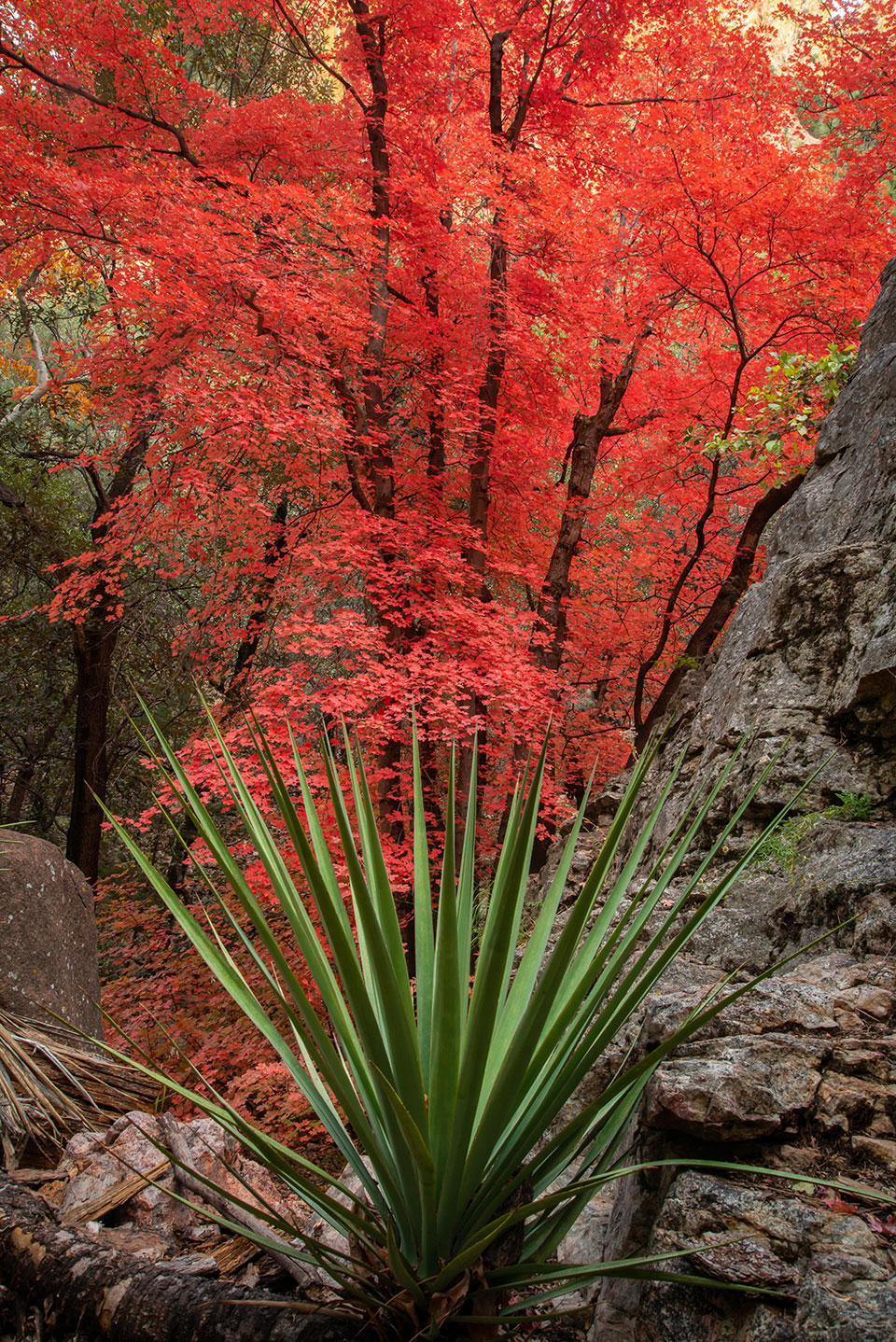
Aspens display their golden leaves along Forest Road 22, a Kaibab National Forest road north of the Grand Canyon’s North Rim. Unlike most deciduous trees, aspens are connected by an extensive root system, meaning each stand constitutes a single organism.
Michael Wilson
NIKON D850, 1/50 SEC, F/8, ISO 400, 100 MM LENS

Maple leaves glow red, orange and yellow in Oak Creek Canyon, north of Sedona. This spot is along the Harding Springs Trail, a hiking route originally used by cattlemen driving their stock into and out of the canyon.
Guy Schmickle
NIKON D800, 2 SEC, F/16, ISO 100, 17 MM LENS

Autumn color proliferates along Aravaipa Creek beneath the steep walls of Aravaipa Canyon, a remote destination northeast of Tucson. The perennial creek, a rarity in Arizona’s desert regions, nurtures a variety of tree species, including cottonwoods, sycamores and willows.
Claire Curran
CANON EOS 5DS R, 1.3 SEC, F/18, ISO 100, 60 MM LENS

A healthy yucca anchors a view of scarlet maple leaves along Cave Creek, a waterway in Southeastern Arizona’s Chiricahua Mountains. Located on the east side of the range, Cave Creek Canyon is known for its maples, sycamores and oaks; typically, fall color there peaks in late October and early November.
Gurinder Singh
NIKON D800, 1/2 SEC, F/22, ISO 400, 34 MM LENS

Arizona sycamore leaves mingle with watercress on the banks of Turkey Creek in the Galiuro Mountains, southwest of Safford. Native to the Southwest and northern Mexico, Arizona sycamores are known for their large leaves, which can be nearly a foot long.
Jack Dykinga
ARCA-SWISS F-FIELD 4X5, FUJICHROME VELVIA, 5 SEC, F/45, ISO 50, 240 MM LENS

October snow and low clouds cloak the San Francisco Peaks, near Flagstaff, as aspen leaves in the Peaks’ lower elevations begin to change. This view is from Hart Prairie Road (Forest Road 151), which runs along the west side of Arizona’s highest mountain range.
Doug Koepsel
NIKON D90, 1/500 SEC, F/6.7, ISO 200, 24 MM LENS

Golden cottonwood leaves contrast with the blue-green water of Havasu Creek, a tributary of the Colorado River in the Grand Canyon. The creek’s color is due to the high levels of calcium carbonate dissolved in the water.
Jeff Maltzman
CANON EOS 5D MARK II, 1/2 SEC, F/22, ISO 50, 45 MM LENS

Maple leaves collect in a low-lying area along the Bear Canyon Trail, in the Tucson area’s Santa Catalina Mountains. Because of its wide variety of elevations and ecosystems, this “sky island” range offers fall color opportunities throughout October and into November.
Paul Gill
CANON EOS 5D MARK III, 1/2 SEC, F/22, ISO 100, 17 MM LENS

Maples show off a range of autumn hues along Workman Creek in the Sierra Ancha, a remote mountain range southeast of Payson. This area can be accessed via Workman Creek Road (Forest Road 487), which begins on State Route 288 north of Globe.
Laurence Parent
SONY ALPHA 7R II, 4 SEC, F/16, ISO 100, 68 MM LENS

The mottled bark of an Arizona sycamore frames vibrant maple leaves in the Miller Peak Wilderness, part of the Huachuca Mountains of Southern Arizona. This view is from the Miller Canyon Trail, where fall color typically peaks in mid- to late October.
Norma Jean Gargasz
NIKON D850, 1/100 SEC, F/11, ISO 160, 50 MM LENS

